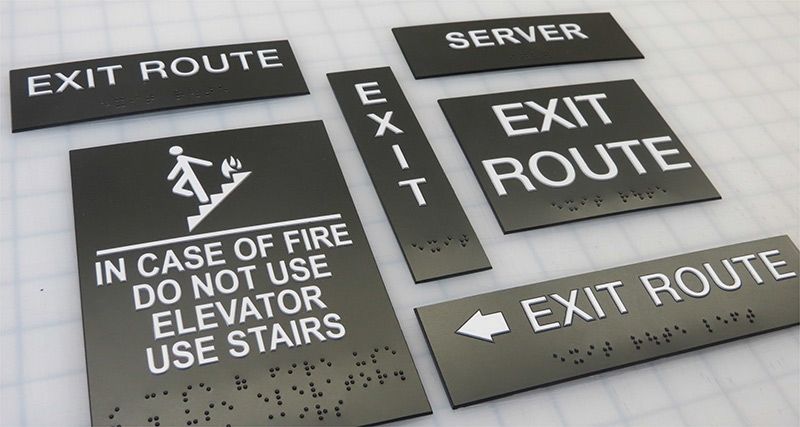Checking Out the Secret Attributes of ADA Signs for Boosted Ease Of Access
In the world of access, ADA signs offer as silent yet effective allies, making sure that spaces are accessible and comprehensive for people with disabilities. By integrating Braille and tactile elements, these indications damage barriers for the aesthetically damaged, while high-contrast color plans and readable font styles cater to diverse visual demands.
Relevance of ADA Conformity
Making sure conformity with the Americans with Disabilities Act (ADA) is important for promoting inclusivity and equivalent gain access to in public areas and workplaces. The ADA, established in 1990, mandates that all public centers, companies, and transportation solutions fit people with impairments, guaranteeing they appreciate the same legal rights and chances as others. Conformity with ADA standards not just fulfills legal commitments however also boosts an organization's online reputation by demonstrating its dedication to diversity and inclusivity.
One of the crucial elements of ADA conformity is the execution of obtainable signage. ADA indications are designed to make certain that individuals with specials needs can easily browse with spaces and buildings. These signs need to adhere to particular standards relating to dimension, font, shade contrast, and positioning to assure exposure and readability for all. Properly executed ADA signage aids get rid of barriers that people with specials needs commonly experience, thereby promoting their independence and self-confidence (ADA Signs).
Moreover, sticking to ADA policies can alleviate the risk of potential fines and legal effects. Organizations that fail to follow ADA standards may deal with fines or legal actions, which can be both financially challenging and destructive to their public picture. Thus, ADA compliance is important to promoting a fair setting for everyone.
Braille and Tactile Aspects
The consolidation of Braille and tactile elements right into ADA signage symbolizes the concepts of access and inclusivity. These functions are critical for individuals who are aesthetically impaired or blind, allowing them to browse public spaces with higher self-reliance and self-confidence. Braille, a responsive writing system, is crucial in offering created information in a style that can be easily perceived via touch. It is generally put beneath the equivalent text on signs to guarantee that people can access the details without visual assistance.
Responsive elements prolong beyond Braille and consist of increased personalities and icons. These elements are made to be noticeable by touch, permitting individuals to identify room numbers, washrooms, departures, and other vital areas. The ADA establishes certain standards pertaining to the size, spacing, and positioning of these tactile components to optimize readability and make certain uniformity throughout different environments.

High-Contrast Shade Schemes
High-contrast color pattern play an essential role in enhancing the exposure and readability of ADA signs for individuals with aesthetic problems. These plans are crucial as they make the most of the distinction in light reflectance between text and history, making certain that signs are conveniently discernible, also from a range. The Americans with Disabilities Act (ADA) mandates the usage of details color contrasts to fit those with minimal vision, making it a vital element of conformity.
The efficacy of high-contrast colors lies in their capacity to stand apart in various illumination problems, including dimly lit settings and locations with glare. Commonly, dark message on a light history or light text on a dark history is employed to attain optimum contrast. For example, black message on a yellow or white history provides a stark aesthetic difference that Find Out More aids in quick recognition and understanding.

Legible Fonts and Text Size
When considering the design of ADA signs, the option of clear font styles and appropriate text dimension can not be overemphasized. These components are essential for guaranteeing that signs come to people with aesthetic problems. The Americans with Disabilities Act (ADA) mandates that typefaces should be sans-serif and not italic, oblique, manuscript, extremely ornamental, or of unusual kind. These requirements aid make sure that the message is quickly understandable from a range and that the characters are appreciable to varied target markets.
According to ADA guidelines, the minimal message height must be 5/8 inch, and it should increase proportionally with seeing range. Uniformity in message dimension contributes to a cohesive aesthetic experience, assisting people in navigating settings efficiently.
Furthermore, spacing in between letters and lines is important to clarity. Ample spacing prevents characters from showing up crowded, enhancing readability. By sticking to these requirements, designers can considerably enhance accessibility, guaranteeing that signage offers its desired objective for all people, regardless of their aesthetic capacities.
Reliable Placement Strategies
Strategic placement of ADA signs is important for making best use of availability and ensuring compliance with legal standards. Effectively located indicators lead people with specials needs properly, promoting navigating in public rooms. Secret factors to consider include visibility, height, and closeness. ADA guidelines stipulate that indications ought to be installed at a height between 48 to 60 inches from the ground to ensure they are within the line of sight for both standing and seated individuals. This basic height variety is important for inclusivity, allowing wheelchair users and people of differing elevations to access info easily.
Additionally, indicators have to be put beside the latch side of doors to enable easy recognition before entrance. This placement helps people find spaces and rooms without blockage. In instances where there is no door, indicators ought to be located on the nearest surrounding wall. Consistency in indicator positioning throughout a center improves predictability, decreasing complication and boosting overall individual experience.

Final Thought
ADA indicators play a crucial function in advertising accessibility by incorporating attributes that address the needs of people with disabilities. These aspects collectively foster a comprehensive environment, emphasizing the importance of ADA compliance in making sure equivalent access for all.
In the realm of access, ADA indications offer as silent yet powerful allies, guaranteeing that spaces are comprehensive and accessible for people with handicaps. The ADA, passed in 1990, mandates that all public centers, employers, and transport services suit individuals with impairments, her response ensuring they enjoy the very same rights and possibilities as others. ADA Signs. ADA signs are developed to make sure that individuals with impairments can see this site quickly browse through structures and rooms. ADA guidelines stipulate that indications need to be installed at an elevation between 48 to 60 inches from the ground to guarantee they are within the line of view for both standing and seated people.ADA indicators play a vital role in promoting accessibility by integrating functions that resolve the requirements of individuals with disabilities